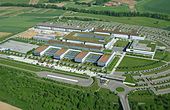- Motronic
-
Motronic is the trade name given to a range of digital engine-management systems developed by Robert Bosch GmbH, commonly known as Bosch.
Contents
Motronic ML1.x
Motronic ML1.x was one of the first digital engine-management systems developed by Bosch. The basic idea behind the system was to fully integrate and regulate all major engine system parameters, thereby enabling fuel delivery and spark timing control functions to be controlled by the same unit, in an attempt to achieve optimum efficiency, driveability and power output potential. These early Motronic systems integrated the spark timing element with then-existing Jetronic fuel injection technology.
It was originally developed and first used in the BMW 7-Series[1], before being implemented on several Volvo[2] and Porsche[3] engines throughout the 1980s. It was also used on turbocharged Audi Quattro models during the early 1990s.
The components of the Motronic ML1.x systems for the most part remained unchanged during production, although there are some differences in certain situations. The engine control module (ECM) receives information regarding engine speed, crankshaft angle, coolant temperature and throttle position. An air flow meter also measures the volume of air entering the induction system.
If the engine is naturally aspirated, an air temperature sensor is located in the air flow meter to work out the air mass. However, if the engine is turbocharged, an additional charge air temperature sensor is used to monitor the temperature of the inducted air after it has passed through the turbocharger and intercooler, in order to accurately and dynamically calculate the overall air mass.
- main system characteristics
- Fuel delivery, ignition timing, and dwell angle incorporated into the same ECM.
- Crank position and engine speed is determined by a pair of sensors reading from the flywheel.
- Separate constant idle speed system monitors and regulates base idle speed settings.
- 5th injector is used to provide extra fuel enrichment during different cold-start conditions. (in some configurations)
- Depending on application and version, an oxygen sensor may be fitted (the system was originally designed for leaded fuel).
- No knock sensor.
Motronic 4.1
The Motronic 4.1 system was used on Opel / Vauxhall eight-valve engines from 1987–1990,[4] and some PSA Peugeot Citroën XU9J-series engines.[5]
The ECM software controls fuel enrichment during cold-start by altering the timing of the main injectors based on engine temperature, no 5th injector is required. The idle speed is also fully controlled by the ECM, including fast-idle during warm-up (no thermo-time switch is required).
The 4.1 system did not include provision for a knock sensor for timing adjustment. The ignition timing and fuel map could be altered to take account of fuels with different octane ratings by connecting a calibrated resistor (taking the form of an "octane coding plug" in the vehicle's wiring loom) to one of the ECU pins, the resistance depending on the octane adjustment required[4]. With no resistor attached the system would default to 98 octane.
The ECM has a single output for the injectors, resulting in all injectors firing simultaneously. The injectors are opened once for every revolution of the engine, injecting half the required fuel each time.[4]
Motronic 1.1 & 1.3
The Motronic 1.1 System was used by BMW from 1987. This was then superseded in 1988 by the Motronic 1.3 system[6] that was also used by PSA on some XU9J-series engines (which previously used Motronic 4.1).[5]
The Motronic 1.1 and 1.3 systems are largely similar, the main improvement being the increased diagnostic capabilities of Motronic 1.3. The 1.3 ECM can store many more detailed fault codes than 1.1, and has a permanent 12-volt feed from the vehicle's battery which allows it to log intermittent faults in memory across several trips. Motronic 1.1 can only advise of a few currently-occurring faults.[6]
The systems include a knock sensor for ignition timing adjustment and the option for a lambda sensor, enabling their use with catalytic converter-equipped vehicles.[5]
The ECMs have 2 injection outputs, and the injectors are arranged in 2 "banks" which fire once every two engine revolutions. In an example 4-cylinder engine, one output controls the injectors for cylinders 1 and 3, and the other controls 2 and 4. The system uses a "cylinder ID" sensor mounted to the cam-shaft to detect which cylinders are approaching the top of their stroke, therefore which injector bank should be fired. During start-up (below 600 RPM), or if there is no signal from the cylinder ID sensor, all injectors are fired simultaneously once per engine revolution.[6]
See also
References
- ^ http://www.bosch.com/content/language2/html/3074_3184.htm
- ^ http://www.ludd.luth.se/~rotax/motronic/motronic.html
- ^ http://frwilk.com/944dme/
- ^ a b c http://www.opel-scanner.com/files/Opel_MotronicML4.1.pdf
- ^ a b c http://www.taylor-eng.com/ecu/motronic_intro.html
- ^ a b c http://www.opel-scanner.com/files/DME_1.1_1.3.pdf
External links
- Bosch.com official website
Bosch Divisions and
subsidiariesCurrentFormer and defunct
Joint ventures and
shareholdingsCurrentFormer and defunctBroadcast Television Systems2 · Japan Electronic Control System2Products People Places Other Bosch fellowship · Bosch process · Robert Bosch Stiftung
1Now integrated into other Bosch divisions or business groupings 2Sold
 Category ·
Category ·  CommonsCategories:
CommonsCategories:- Fuel injection systems
- Embedded systems
- Power control
- Engine technology
- Automotive technology tradenames
Wikimedia Foundation. 2010.
